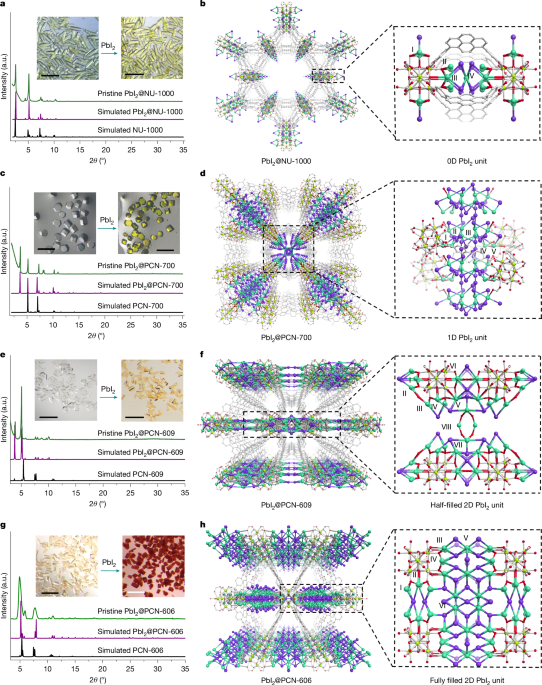Esaki, L. & Chang, L. L. New transport phenomenon in a semiconductor “superlattice”. Phys. Rev. Lett. 33, 495–498 (1974).
Novoselov, K. S. et al. 2D materials and van der Waals heterostructures. Science 353, aac9439 (2016).
Udayabhaskararao, T. et al. Tunable porous nanoallotropes prepared by post-assembly etching of binary nanoparticle superlattices. Science 358, 514–518 (2017).
Pham, P. V. et al. 2D heterostructures for ubiquitous electronics and optoelectronics: principles, opportunities, and challenges. Chem. Rev. 122, 6514–6613 (2022).
Wan, Z., Qian, Q., Huang, Y. & Duan, X. F. Layered hybrid superlattices as designable quantum solids. Nature https://doi.org/10.1038/s41586-024-07858-3 (2024).
Murray, C. B., Kagan, C. R. & Bawendi, M. G. Self-organization of CdSe nanocrystallites into three-dimensional quantum dot superlattices. Science 270, 1335–1338 (1995).
Dong, A. et al. Binary nanocrystal superlattice membranes self-assembled at the liquid–air interface. Nature 466, 474–477 (2010).
Gudiksen, M. S. et al. Growth of nanowire superlattice structures for nanoscale photonics and electronics. Nature 415, 617–620 (2002).
Robinson, R. D. et al. Spontaneous superlattice formation in nanorods through partial cation exchange. Science 317, 355–358 (2007).
Liu, Y. et al. Van der Waals heterostructures and devices. Nat. Rev. Mater. 1, 16042 (2016).
Kang, K. et al. Layer-by-layer assembly of two-dimensional materials into wafer-scale heterostructures. Nature 550, 229–233 (2017).
Devarakonda, A. et al. Clean 2D superconductivity in a bulk van der Waals superlattice. Science 370, 231–236 (2020).
Li, J. et al. Towards the scalable synthesis of two-dimensional heterostructures and superlattices beyond exfoliation and restacking. Nat. Mater. 23, 1326–1338 (2024).
Wang, C. et al. Monolayer atomic crystal molecular superlattices. Nature 555, 231–236 (2018).
Qian, Q. et al. Chiral molecular intercalation superlattices. Nature 606, 902–908 (2022).
Wan, Z. et al. Unconventional superconductivity in chiral molecule–TaS2 hybrid superlattices. Nature 632, 69–74 (2024).
Zhou, J. et al. Modular assembly of a library of hybrid superlattices and artificial quantum solids. Matter. 7, 1131–1145 (2024).
Yaghi, O. M., Li, G. & Li, H. Selective binding and removal of guests in a microporous metal–organic framework. Nature 378, 703–706 (1995).
Fujita, M. et al. Preparation, clathration ability, and catalysis of a two-dimensional square network material composed of cadmium(II) and 4,4′-bipyridine. J. Am. Chem. Soc. 116, 1151–1152 (1994).
Sung Cho, H. et al. Extra adsorption and adsorbate superlattice formation in metal–organic frameworks. Nature 527, 503–507 (2015).
Pang, J. et al. Enhancing pore-environment complexity using a trapezoidal linker: toward stepwise assembly of multivariate quinary metal–organic frameworks. J. Am. Chem. Soc. 140, 12328–12332 (2018).
Chen, Z. et al. Reticular chemistry in the rational synthesis of functional zirconium cluster-based MOFs. Coord. Chem. Rev. 386, 32–49 (2019).
Chen, Y. et al. Programmable water sorption through linker installation into a zirconium metal–organic framework. J. Am. Chem. Soc. 146, 11202–11210 (2024).
Bloch, W. M. et al. Capturing snapshots of post-synthetic metallation chemistry in metal–organic frameworks. Nat. Chem. 6, 906–912 (2014).
Volosskiy, B. et al. Metal–organic framework templated synthesis of ultrathin, well-aligned metallic nanowires. ACS Nano 9, 3044–3049 (2015).
Lee, S., Kapustin, E. A. & Yaghi, O. M. Coordinative alignment of molecules in chiral metal–organic frameworks. Science 353, 808–811 (2016).
Kim, C. R., Uemura, T. & Kitagawa, S. Inorganic nanoparticles in porous coordination polymers. Chem. Soc. Rev. 45, 3828–3845 (2016).
Gonzalez, M. I. et al. Confinement of atomically defined metal halide sheets in a metal–organic framework. Nature 577, 64–68 (2020).
Jiang, Z. et al. Filling metal–organic framework mesopores with TiO2 for CO2 photoreduction. Nature 586, 549–554 (2020).
Zigon, N. et al. Crystalline sponge method: X-ray structure analysis of small molecules by post-orientation within porous crystals-principle and proof-of-concept studies. Angew. Chem. Int. Ed. 60, 25204–25222 (2021).
Inokuma, Y., Arai, T. & Fujita, M. Networked molecular cages as crystalline sponges for fullerenes and other guests. Nat. Chem. 2, 780–783 (2010).
Deng, X. et al. Metal–organic framework coating enhances the performance of Cu2O in photoelectrochemical CO2 reduction. J. Am. Chem. Soc. 141, 10924–10929 (2019).
Malgras, V. et al. Observation of quantum confinement in monodisperse methylammonium lead halide perovskite nanocrystals embedded in mesoporous silica. J. Am. Chem. Soc. 138, 13874–13881 (2016).
Demchyshyn, S. et al. Confining metal-halide perovskites in nanoporous thin films. Sci. Adv. 3, e1700738 (2017).
Steeger, P. et al. Hysteretic piezochromism in a lead iodide-based two-dimensional inorganic–organic hybrid perovskite. J. Am. Chem. Soc. 146, 23205–23211 (2024).
Hahm, D. et al. Direct patterning of colloidal quantum dots with adaptable dual-ligand surface. Nat. Nanotechnol. 17, 952–958 (2022).
Fei, C. et al. Lead-chelating hole-transport layers for efficient and stable perovskite minimodules. Science 380, 823–829 (2023).
Cai, J. et al. Enhancing circularly polarized luminescence in quantum dots through chiral coordination-mediated growth at the liquid/liquid interface. J. Am. Chem. Soc. 145, 24375–24385 (2023).
Chen, Y. et al. Manipulation of valley pseudospin by selective spin injection in chiral two-dimensional perovskite/monolayer transition metal dichalcogenide heterostructures. ACS Nano 14, 15154–15160 (2020).
Ma, J., Wang, H. & Li, D. Recent progress of chiral perovskites: materials, synthesis, and properties. Adv. Mater. 33, 2008785 (2021).
Long, G. C. et al. Spin control in reduced-dimensional chiral perovskites. Nat. Photon. 12, 528–533 (2018).
Long, G. et al. Chiral-perovskite optoelectronics. Nat. Rev. Mater. 5, 423–439 (2020).
Zhang, D. et al. Atomic-resolution transmission electron microscopy of electron beam–sensitive crystalline materials. Science 359, 675–679 (2018).
Dong, J. et al. Free-standing homochiral 2D monolayers by exfoliation of molecular crystals. Nature 602, 606–611 (2022).
Zhu, Y. et al. Unravelling surface and interfacial structures of a metal–organic framework by transmission electron microscopy. Nat. Mater. 16, 532–536 (2017).
Sheldrick, G. M. SADABS, program for empirical absorption correction of area detector data (Univ. Göttingen, 1996).
Kühne, T. D. et al. CP2K: an electronic structure and molecular dynamics software package—Quickstep: efficient and accurate electronic structure calculations. J. Chem. Phys. 152, 194103–194150 (2020).
Perdew, J. P., Burke, K. & Ernzerhof, M. Generalized gradient approximation made simple. Phys. Rev. Lett. 77, 3865–3868 (1996).
VandeVondele, J. & Hutter, J. Gaussian basis sets for accurate calculations on molecular systems in gas and condensed phases. J. Chem. Phys. 127, 114105 (2007).
Grimme, S. et al. A consistent and accurate ab initio parametrization of density functional dispersion correction (DFT-D) for the 94 elements H–Pu. J. Chem. Phys. 132, 154104 (2010).


